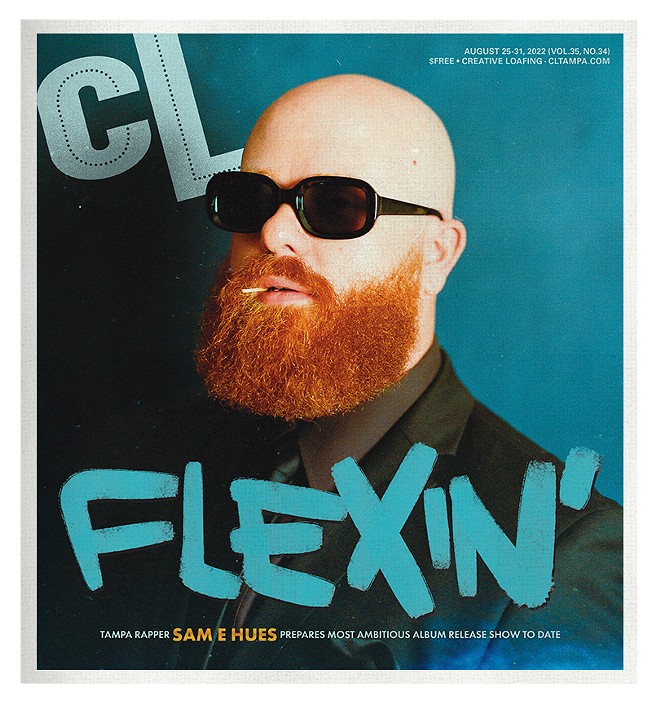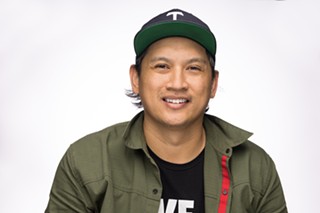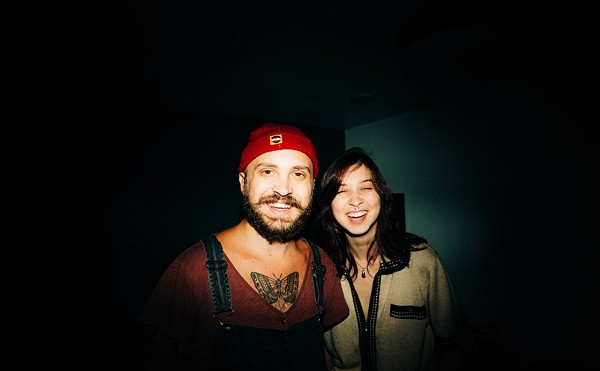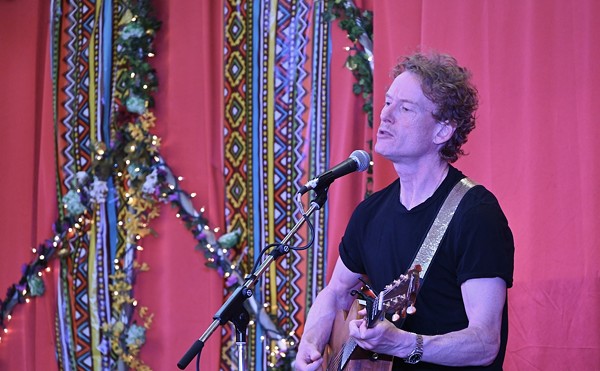
Three years ago Hues took to Skipper’s Smokehouse and staged the storied blues venue’s first-ever rap show where he also turned the stage into the mouth of a tiger. The scene underneath the Skipperdome was unprecedented, complete with live podcast tapings and a cadre of Hues’ favorite emcees warming up the 40-year-old stage before a full band, complete with horns, helped Hues show Easy Tiger to his fans for the very first time.
This weekend on Saturday Aug. 27, Hues is set to do it again in a different venue, Ybor City’s Centro Asturiano, where just he and scene favorite DJ Qeys will take to the 120-year-old venue’s stage and present the rapper’s most fully-realized album to date, When Tigers Used To Smoke.
“I chose Centro for a few reasons. For one, the halls smell of tobacco and cigars, the smell adds to the experience,” Hues told Creative Loafing Tampa Bay. “I knew I wanted a theater the moment I started the album.”
To be clear, Hues’ brain seems to always think about nearly all the ancillary elements of his art, and how the details complement each other at every turn of a project, all at the same time. For this show, he even played carpenter and literally helped build the stage elements. Ahead of the video shoot for lead single “Outside,” Hues and his team painted his St. Petersburg home hot pink, replanted flower beds, installed thicker grass then painted it green, and even hand-dyed overalls the guest artist wore—all to get the color palette just right. The day after shooting, he painted his house back to its normal color.
“The neighbors were driving by all week just watching me do it,” he laughed.
Hues also joked about how his mom’s voice—which appeared on past records to give advice or just crack one liners—didn’t make it to the tape this time. “I’m giving her a break for this one, but you she’s always close by,” he said.
Mom being on the sideline isn’t the only thing different about this outing. Unlike past work, the 30-minute effort is also devoid of any unambiguous love songs directed at his muse and longtime partner (instead, the album’s title is a nod to Korean folklore and storytelling, an homage to her culture and background). Hues’ move to forgo backup singers, guitars and horns in his live setup is also no accident. More than any of his past work, When Tigers Used To Smoke is the most accurate representation of who Hues, the individual, is at the moment of the release.
After his Cruise Control Radio EP—a 2020 release built around the concept of a trip to the corner store, and timed exactly to the length of the car ride—Hues shuffled his cards, spending the last three years working on other projects including Ybor’s since-shuttered Dojo Sounds and now-thriving Five 5 Studios, which he co-owns. He also co-wrote for and helped manage locally-based “The Voice” country star Kenzie Wheeler.
Inevitably, Hues started making music for himself again before finding himself stuck.
“I started a lot of songs but didn’t finish too many of them. But then I met Guy Average,” Hues explained, referencing a producer who was at Five 5 working on other projects. “I would overhear him working. We linked up and it clicked, today I would say he’s one of my closest friends.”
Average produced the entirety of When Tigers Used To Smoke. Together, he and Hues started 20 songs, finished 14 and settled on 11 tracks that Maxx Forman mastered to seamlessly weave in an out of each other in a slow-building release that culminates in a three-song suite of party-ready, quintessentially Southern, hip-hop (“Same Thing” even features local Jagjaguwar signees They Hate Change).
“The slow burn was intentional. It’s me burning one version of myself and revealing another,” Hues said. The layers and different chapters, mistakes, dues paid, good and bad times, are all there. “It also took me a lifetime to be me, so slow felt right.”
But don’t mistake slow for insubstantial. When Tigers Used To Smoke is the spark of a journey. Hues and his business partner Dann Druen have started an LLC and hope to roll out fashion elements, along with home goods, large scale art, experiences and maybe even culinary projects (Flan Factory across the street from Centro Asturiano is selling a signature When Tigers Used To Smoke dessert). A lot more music in on the horizon, too.
In the meantime, Hues invites the community to watch him peel back all the layers of who he is as part of an immersive experience complete with a curated menu by Filipino pop-up kitchen Lucky Tigre, photobooth run by downtown Tampa studio WTRcooler, and other surprise elements.
And while When Tigers Used To Smoke is very much about the transformation of Sam E Hues, the rapper’s community will very much drive the action. Openers are, again, all his current favorites and represent the different energy on the album. And under his direction, Hues’ collaborators will be the ones holding him up the whole time.
“It takes a team to execute a large vision, I just believe I’m more open about it. I’m proud of the people I work with, most of them are like family,” he said. “I think the biggest misconception is that there is such a thing as a solo artist. No one can do it all on their own.”



















